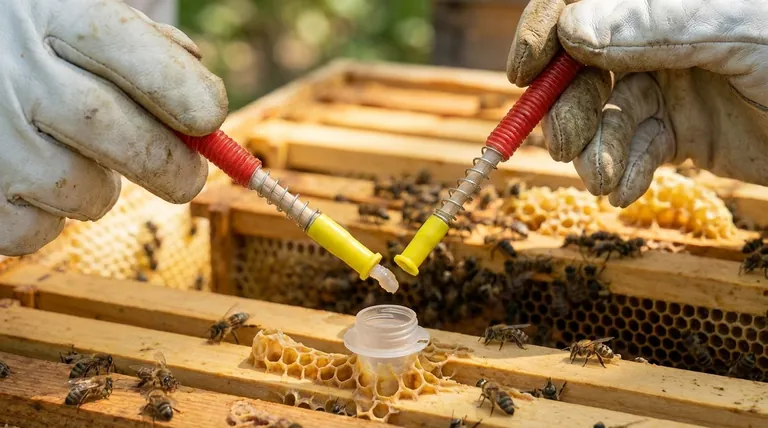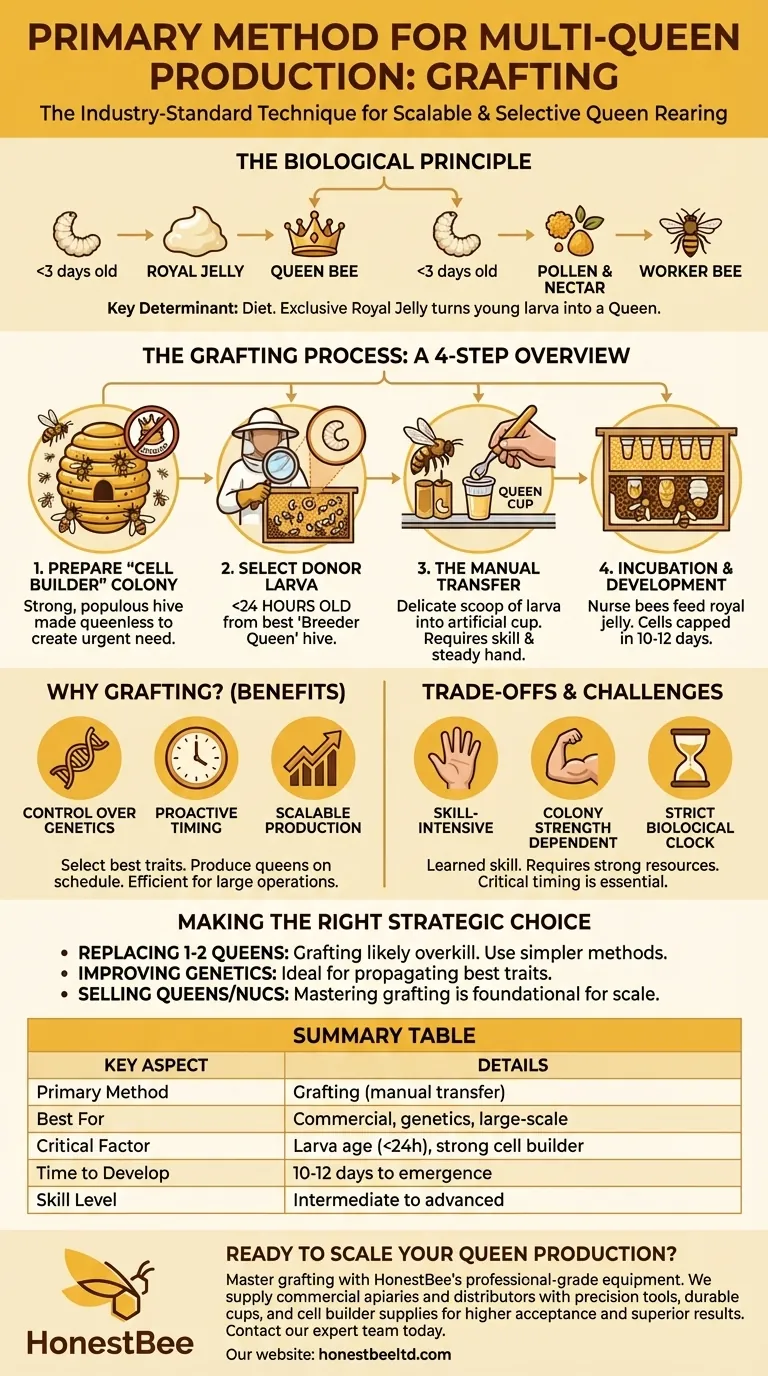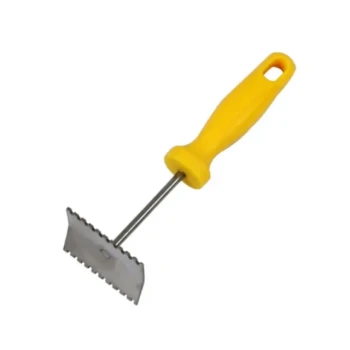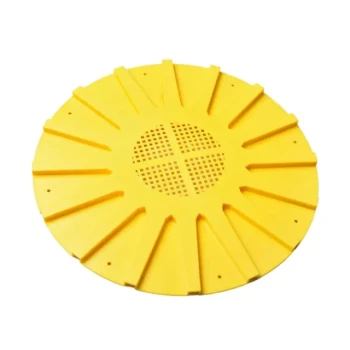For beekeepers who need to produce multiple queen bees in a season, the industry-standard method is a technique known as grafting. This process involves manually transferring a very young female larva from a worker bee cell into a specially prepared queen cup, which is then placed in a colony primed to raise new queens.
The core challenge in beekeeping is managing colony reproduction and genetics predictably. Grafting solves this by giving the beekeeper direct control over which bees become queens and when they are produced, moving beyond the hive's natural, often unpredictable, instincts.

Why Grafting is the Standard for Queen Rearing
Grafting is not just a technique; it's a system that allows for scalable and selective queen production. It bypasses the natural, and often inefficient, methods of queen replacement that a colony would undertake on its own.
The Biological Principle at Work
At the heart of grafting is a simple biological fact: any female larva younger than three days old can become a queen. The key determinant is her diet.
If a larva is fed exclusively royal jelly by nurse bees, she develops into a queen. If she is fed a mix of pollen and nectar after day three, she becomes a worker bee. Grafting simply puts a chosen larva into a situation where the bees have no choice but to give it this royal treatment.
Control Over Genetics and Timing
Natural queen events, like swarming or supersedure (replacing a failing queen), are reactive and unpredictable. Grafting gives the beekeeper proactive control.
Beekeepers can select larvae from their best hives—those that are gentle, productive, and disease-resistant. This allows for the systematic improvement of the entire apiary's genetic stock. You produce the queens you need, from the stock you want, exactly when you need them.
The Grafting Process: A Step-by-Step Overview
While it requires skill, the grafting process follows a logical sequence. Success depends on preparation, timing, and a gentle touch.
Step 1: Prepare the "Cell Builder" Colony
A strong, populous colony is designated as the cell builder. This hive must be overflowing with young nurse bees, which are responsible for producing royal jelly.
The colony is typically made queenless a day or so before introducing the grafts. This creates an urgent biological need to raise a new queen, ensuring the grafted larvae are accepted and fed immediately.
Step 2: Select the Donor Larva
The beekeeper chooses a "breeder queen" hive with desirable traits. A frame of her brood is inspected to find the ideal larvae for grafting.
The target is a larva that is almost too small to see, typically less than 24 hours old. These C-shaped larvae are floating in a pool of royal jelly, making them easier to transfer.
Step 3: The Manual Transfer
Using a specialized grafting tool, the beekeeper carefully scoops the tiny larva out of its worker cell and places it into an artificial queen cup, which can be made of plastic or wax.
This is the most delicate part of the process and requires good lighting, a steady hand, and practice to avoid damaging the larva. Dozens of these cups are typically prepared and fixed to a frame.
Step 4: Incubation and Development
The frame containing the grafted queen cups is placed into the prepared cell builder colony. The nurse bees quickly find the larvae, begin feeding them massive amounts of royal jelly, and draw out the cups into full-sized queen cells. Over the next 10-12 days, these cells will be capped and the larvae will develop into queens.
Understanding the Trade-offs and Challenges
Grafting is powerful, but it is not without its difficulties. Success is not guaranteed and depends on several critical factors.
A Skill-Intensive Task
Grafting is a learned skill. It demands good eyesight, manual dexterity, and patience. Many beginners have low success rates ("acceptance rates") at first, but proficiency grows with practice.
The Importance of Colony Strength
The success of queen rearing is directly tied to the health and strength of the cell builder colony. A weak hive, or one with insufficient resources and nurse bees, will not build high-quality queen cells, if it accepts them at all.
Timing is Everything
The entire process operates on a strict biological clock. Larvae must be the correct age, the cell builder must be primed at the right time, and the finished queen cells must be moved to their new colonies before the first virgin queen emerges and kills all of her rivals.
Making the Right Choice for Your Goal
Understanding grafting allows you to choose the right queen-rearing strategy for your specific needs.
- If your primary focus is replacing one or two queens: Grafting is likely overkill; simpler methods like creating a "walk-away split" and letting the bees raise their own emergency queen are more practical.
- If your primary focus is improving your apiary's genetics: Grafting is the ideal tool for selecting traits from your best hives and propagating them throughout your operation.
- If your primary focus is selling queens or nucleus colonies: Mastering grafting is a foundational and non-negotiable skill for achieving the scale required for a commercial business.
Ultimately, learning to graft transforms a beekeeper from a passive manager into an active architect of their apiary's health and future.
Summary Table:
| Key Aspect | Details |
|---|---|
| Primary Method | Grafting (manual transfer of young larvae) |
| Best For | Commercial apiaries, genetic improvement, large-scale production |
| Critical Factor | Larva age (<24 hours old), strong cell builder colony |
| Time to Develop | 10-12 days from grafting to queen emergence |
| Skill Level | Intermediate to advanced (requires practice) |
Ready to Scale Your Queen Production with Professional-Grade Equipment?
Mastering grafting requires reliable, high-quality tools. At HONESTBEE, we supply commercial apiaries and beekeeping equipment distributors with wholesale-focused solutions. From precision grafting tools to durable queen cups and cell builder supplies, our equipment helps you achieve higher acceptance rates and superior genetic outcomes.
Contact our expert team today to discuss your specific needs and discover how our beekeeping supplies can enhance your queen-rearing success.
Visual Guide

Related Products
- Retractable Chinese Queen Rearing Grafting Tools Equipment
- Nicot Queen Rearing Kit for Beekeeping and Grafting in Nicot System
- Jenter Queen Rearing Kit Complete Set for Bee Breeding
- Plastic Chinese Queen Grafting Tool for Bee Queen Rearing
- No Grafting Queen Rearing Kit: System for Royal Jelly Production and Queen Rearing
People Also Ask
- What are the steps involved in the grafting process? Master Queen Rearing for Your Apiary
- What is the Doolittle method of queen rearing? Master Controlled Queen Production for Your Apiary
- What should be done to ensure grafted larvae are well-fed? Master the Principle of Abundance for Queen Rearing
- What characteristics make larvae suitable for grafting? Select the Perfect Larva for Queen Rearing
- What is the process of grafting larvae? Master the Art of Queen Rearing for Your Apiary



















